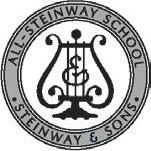

Park University International Center for Music Presents



Park University International Center for Music Presents

Friday, March 14, 2025 • 7:30 p.m. 1900 Building • Mission Woods, KS



Dear Esteemed Patrons and Lovers of Music,
As we embark on a new season at the International Center for Music at Park University, I find myself reflecting on the profound impact that music has on our lives. It’s not just the sound that resonates, but the emotion and dedication behind every performance that truly moves us. As Artistic Director and founder of this institution, I am continuously inspired by the exceptional talents of our students, faculty, and guest artists who pour their hearts into their craft. Kansas City is a remarkable place, home to a community that cherishes and supports the arts with unparalleled enthusiasm. Our concert series is designed to bring you closer to the magic of live music, offering an intimate and accessible way to experience the brilliance of our performers.
Our mission remains steadfast: to create an environment where musical excellence thrives, free from the distractions and financial burdens that often hinder artistic growth. At Park ICM, we are committed to nurturing the next generation of musicians with the same intensity and focus that shaped my own musical journey.
This season, we are proud to present a lineup that includes not only our extraordinary students and faculty but also internationally acclaimed guest artists whose contributions to the world of music are nothing short of legendary. In keeping with our mission, we will also introduce you to the newborn stars, the bright talents who represent the future of classical music. Each concert is an opportunity to witness the convergence of passion, discipline, and talent, creating moments that linger in the heart and mind.
I invite you to join us in celebrating the transformative power of music. Your presence and support are invaluable to us, fueling our drive to reach new heights of artistic achievement. Together, let’s create a symphony of shared experiences that transcends time and space.
With deep gratitude,


Stanislav Ioudenitch Founder and Artistic Director International Center for Music at Park University
P.S. Each performance is a manifestation of our shared love for music. Your presence and applause amplify our drive to elevate the art form further.
SONATA FOR VIOLIN AND PIANO NO. 32, K.454 IN B -FLAT MAJOR
Wolfgang Amadeus Mozart (1756-1791)
Largo – Allegro
Andante
Allegretto
Jan Radzynski (b.1950)
5 MELODIES, FOR VIOLIN AND PIANO OP. 35
Sergei Prokofiev (1891-1953)
Andante
Lento, ma non troppo
Animato, ma non allegro
Allegretto leggero e scherzando
Andante non troppo
SONATA FOR VIOLIN AND PIANO NO.3, OP.45 IN C-MINOR
Edvard Grieg (1843-1907)
Allegro molto ed appassionato
Allegretto espressivo alla Romanza
Allegro animato

David Radzynski served as concertmaster of The Cleveland Orchestra from 2022-2024 after eight years serving as concertmaster of the Israel Philharmonic Orchestra (IPO). David enjoys collaborating regularly with major conductors and soloists in solo, chamber music, and orchestral settings.
Some of his memorable performances as soloist include concerts with the Israel Philharmonic Orchestra and Manfred Honeck, Zubin Mehta and the IPO at the Musikverein in Vienna, with the Łódź Philharmonic in Poland, the Polish National Philharmonic, the Columbus Symphony, and the Amadeus Chamber Orchestra of Poznan where he premiered the double concerto composed by his father Jan Radzynski.
An avid chamber musician, David has performed with Emanuel Ax, Pinchas Zukerman and Martha Argerich, among others. He has also performed as guest concertmaster with the Houston Symphony, Pittsburgh Symphony, and Cincinnati Symphony Orchestras.
David holds a bachelor’s degree from Indiana University, a master’s degree from Yale, and artist certificate from the International Center for Music at Park University. His violin teachers include Roland and Almita Vamos, Paul Kantor, Mauricio Fuks and Kevork Mardirossian at Indiana University, Syoko Aki at the Yale School of Music, and Ben Sayevich at the International Center for Music at Park University.

Lolita Lisovskaya-Sayevich ICM Director of Collaborative Piano
Born into a Tashkent (Uzbekistan) musical family, Lolita Lisovskaya-Sayevich began studying piano at the age of 4. In 1985, she entered the Uspensky Central Music School in Tashkent. In 1993, she started attending a private school for young musicians in Moscow, and that same year received the first prize at the Chopin International Piano Competition in Göttingen, Germany. She entered the Tchaikovsky Special Music School in 1995, and two years later was accepted to the Tchaikovsky Moscow Conservatory under the tutelage of Vera Gornostaeva, with whom she continued postgraduate study from 2002 to 2004. Lisovskaya-Sayevich also studied with Stanislav Ioudenitch at Park University.
In 1996, Lisovskaya-Sayevich received the first prize from the Nikolai Rubinstein International Piano Competition, and in 2007 the first prize at the Iowa International Piano Competition. She was awarded scholarships from the Rostropovich Foundation, the Spivakov Foundation and the Nikolai Petrov Foundation. She has also earned the laureate designation from the international program “New Names,” and the festival “Virtuoso 2000” in St. Petersburg, Russia. Lisovskaya-Sayevich has recorded at the Hessen Radio Station in Frankfurt, Germany, and at Orfei Radio in Moscow.
Lisovskaya-Sayevich has presented numerous solo recitals and has played as a soloist with orchestras in Austria, France, Japan, Spain, Germany, Hungary, Italy and Russia. She has participated in many music festivals, including the Bashmet Festival in Tours, France, “Wave 2000” in Japan, International Musical Arts Institute in Maine (USA), Killington Music Festival in Vermont (USA), “Ars Longa” and “Primavera Classica” in Moscow. She has collaborated with such renowned musicians as Daniel Müller-Schott, Shmuel Ashkenasi, members of the Boston Symphony Orchestra and many others. She now performs extensively in chamber music ensembles.

That Mozart could produce, in a mere 35 years, a body of work unlike anything the Western world had ever heard is miracle enough. Even more remarkable is the fact that the majority of masterworks for which he is best known are the product of a single decade — from his arrival in Vienna in 1781 to his mysterious, premature death in 1791.
In 10 years he composed the “Great” Mass and the Requiem; the operas Marriage of Figaro, Don Giovanni, Così fan tutte, La clemenza di Tito, and The Magic Flute; six magisterial symphonies; 17 Piano Concertos (Nos. 11-27); concertos for horn and clarinet; serenades and other incidental music; and dozens of trios, quartets, and quintets that altered the course of chamber music forever. Though he composed violin sonatas throughout his life, nothing compares with the final three (K. 454, K. 481, and K. 526), which stand side-by-side with his greatest achievements.
Music often poured from Mozart’s pen so quickly that he scarcely had time to finish writing it out in time for a scheduled performance. (More than once he wrote to his father that a piece was “composed, but not yet written down.”) The first of these three Sonatas (No. 32 in B-flat major) was apparently one such work. During the spring of 1784, the virtuoso violinist Regina Strinasacchi appeared in Vienna. “We have the famous Strinasacchi from Mantua right now,” Mozart wrote to Leopold, “a very good violinist with excellent taste and a lot of feeling in her playing. I am composing a sonata for her [K. 454] that we will be playing together on Thursday at her concert at the [Kärntnerthor]theater.”
What Mozart neglects to tell his father is that by concert time he had written out only the violin line, and thus had to play the keyboard part from memory. The manuscript bears this out: The violin part looks well-proportioned on the page, while the piano part is crowded awkwardly into the lower staves and written in a different ink — clearly a later addition.
The Largo introduction of K. 454 signals immediately that violin and piano are to be equal partners. This well-tempered exchange of themes continues into the Allegro, a witty and talkative dialogue. The discursive Andante is like an opera aria; one can easily imagine that Mozart tailored this movement to Strinasacchi’s celebrated bel canto. The final Allegretto is a playful and joyous rondo.
Jan Radzynski, who is David’s father, has spent a rich career dwelling within the most vibrant worlds of 20th and 21st-century music. Essentially a lyricist at heart, the Warsaw-born musician has not shied from the complexity of post-World War II styles, which he has approached with consummate technical skill and an ear toward approachable textures, dynamic rhythms, and bold harmonic language. Often tinged with piquant folk tunes or existing materials from a range of Jewish and other Middle Eastern traditions, his scores are as colorful and varied as contemporary music itself.

Radzynski left his native Poland in 1969, settling first in Israel, where he was a composition student of León Schidlowsky at Tel Aviv University Academy of Music. At Yale University he studied subsequently with two of the towering figures of 20th-century music, Polish-born Krzysztof Penderecki and the American “post-Romanticist” (and master of orchestral textures) Jacob Druckman. Radzynski earned his doctorate in 1984 and, after a stint teaching at Yale, in 1994 he became professor of Composition and Theory of Music at The Ohio State University.
He has received awards and grants from the Rothschild Foundation, the Mellon and Morse Foundations, the Ohio Arts Council, the Connecticut Commission on the Arts, and many others. He held a Summer Residency at the Foundation Artist’s House in Boswil, Switzerland. His Kaddish: to the Victims of the Holocaust (1979) was awarded a commendation at the International Rostrum of Composers in
Paris. His works have been performed by major ensembles such as the Cleveland Orchestra, the Israel Philharmonic, the Saarbrücken Radio Orchestra, the New Haven Symphony, and the Polish National Philharmonic. His compositions have been recorded on CRI, Delos, Naxos, Centaur, Channel Classics, and Music in Israel.
Radzynski has produced orchestral music (including a symphony David,1987, and Time’s Other Beat, 1990); concertos for piano, cello, and viola; chamber works (String Trio, 1995, Take Five for brass quintet, 1984), and solo piano works (Canto, 1981). His expansive Shirat Ma’ayan for voices and orchestra is a setting of Psalms 46 and 137. Personal Verses, one of his most engaging chamber works, is filled with exuberance and virtuosity. The composer has written the following about the piece:
“Personal Verses for violin and piano, composed in 1999 for pianist Golda Vainberg and Lithuanian violinist Raimundas Katilius, is composed of three contrasting movements: a dance-like Vivo e risoluto, a slow Andante, and a relentless, frenzied Con moto. The first movement (Vivo e risoluto) features three fast dances: mazurka, waltz, and Israeli hora. A Chopinesque mazurka opens the movement in a decisive, straightforward fashion, but it acquires a melismatic quality with increased ornamentation. The mazurka morphs into a brief waltz, which serves as transition to a spirited hora. The hora recalls the dance of Jewish pioneers in Eretz Yisrael. The movement concludes with the return of the mazurka.
“The middle (Andante) movement … opens with a lyrical melody that is gradually transformed into a foreboding march. The middle section of Andante includes an impassioned violin cadenza. The movement then returns to the opening melody, this time dramatically interrupted by a quotation from the famous Zog Nisht Keyn Mol (Don’t Ever Say This is the Last Road), a defiant song from the Vilnius Ghetto that became the anthem of Jewish partisans during World War II.
“Personal Verses concludes with a forward-driving, perpetual-motion Con moto. If the first two movements look back at the yellowed photographs in the family album, the obsessive Con moto belongs to the present, the here and now. Certainly this movement does not attempt to reconcile with the past. A dialogue
with the past becomes impossible, given its horrific history. But the lessons of history seem to have never really been learned. What remains is obsession, madness, and a cry of despair.”

The resemblance of the violin’s sonority to that of the human voice is at times so striking that some have speculated that this might have been a goal among the great Cremona instrument-makers. An emphasis on producing a “singing” tone in instrumental music has been prevalent at least since the Baroque: In his 1751 treatise L’art de jouer le violon, the 18th-century violinist Francesco Geminiani wrote that “the art of playing the violin consists in giving that instrument a tone that shall, in a manner, rival the most perfect human voice.”
This relationship is borne out in music through the centuries. Prokofiev’s Five Melodies from the 1920s were originally written for wordless voice and later adapted for violin. It happened shortly after he had made his way to the United States — via the Trans-Siberian Railway and an ocean liner from Tokyo to San Francisco. He eventually arrived in Chicago and, later, New York. The Chicago Opera Company had shown interest in an opera he had begun in Russia, The Love for Three Oranges, and although it was postponed initially, it did finally reach the Chicago stage in 1921.
Prokofiev often came upon emigré artists on his travels. One was the Kiev-born soprano Nina Koshetz, who originated the role of Fata Morgana in Three Oranges. Prokofiev was fascinated with her rich, dramatic voice, and he wrote for her five vocalises he called Songs Without Words, later published as Op. 35. They were not what Koshetz had imagined. “One of them, No. 3, has an appealing melody, but frankly the harmonies frighten me,” she wrote. “Three others are enchanting but better for St. Petersburg. … I’m afraid the song in A major (No. 4) is beyond me technically.” In the end, Koshetz only performed two
of the songs in her New York recital. Meanwhile, Prokofiev pondered how to make better use of them.
In 1925 the composer adapted the five “songs” for violin and piano, dedicating them to emigré violinists he had encountered: Cecilia Hansen (No. 2), Joseph Szigeti (No. 5), and Pawel Kochański (Nos. 1, 3, and 4). The solo parts were enhanced — with double-stops, harmonics, and pizzicatos. Later that year, in Paris, he and Kochański performed the set, which was later published as Op. 35a (or 35bis).
The Andante states a typically angular theme that stays in the memory; the Lento, ma non troppo contrasts an expansively lyrical theme with a darker, quasi-modal section, before returning to the C-major opening. The Animato, ma non allegro feels optimistic and tenderly energetic; it, too, contains a pensive central section (Meno mosso). The Allegretto leggero e scherzando was the piece Koshetz was most concerned about singing, and one can see why — although its dashing forward-motion feels natural on the violin. The Andante non troppo concludes the set with an expansively lyrical, almost operatic, tune, juxtaposed with a slower section (Pochissimo più animato).
Grieg has long been revered by Norwegians as a conservator of their heritage. But he established a musical identity of such global distinction that we hold his works to be among the finest of 19th-century music. As a young man he had prepared for a career as concert pianist, developing his considerable gifts at the keyboard at the Leipzig Conservatory. Although he never completing his course of study there, it was during this period that he became quite well acquainted with the central figures and musical institutions of the day.

He also explored folk music of his native Norway throughout his life, at the same time assimilating the dominant strains of pan-European music. His admiration for the music of Mendelssohn, Schumann, Brahms, and Tchaikovsky is evident, and
frequently this respect flowed in both directions. “What warmth and passion in Grieg’s melodic phrases,” wrote Tchaikovsky of the composer he admired perhaps more than any other of his contemporaries. “What originality and beauty in the turn of his piquant, ingenious modulations and rhythms, and in all the rest — what interest, novelty, and independence!”
In addition to well-known works such as Peer Gynt, the Holberg Suite, and the Piano Concerto, Grieg composed a large quantity of vocal, solo piano, and chamber music. He regarded his three Sonatas for Violin and Piano as some of his best music. “They represent periods in my development,” he wrote in 1900. “The first naïve and rich in ideas, the second ‘national,’ and the third with a wider horizon.”
The Op. 45 Sonata bears a dedication to the painter Franz von Lenbach — offered as a token of appreciation for the fine portrait of Grieg’s wife, Nina, that Lenbach had painted a few years earlier. Unlike his first two sonatas, which were simpler in design and conceit, the third was the product of several months of effort in 1886 and early 1887 — inspired, evidently, by his recent acquaintance with the gifted young violinist Teresina Tua. “I am writing a piece of chamber music,” he wrote to his publisher, Max Abraham, “and only God knows when it will be finished.” The sonata was completed in January 1887 and received its premiere in Leipzig, with violinist Adolph Brodsky and the composer on piano.
The C-minor Sonata is at turns darkly dramatic and tranquil. The opening movement (Allegro molto ed appassionato) is one of bold theatrics, while the Allegretto espressivo (“alla Romanza”) juxtaposes a lyrical theme with a spirited dance section. The final Allegro animato places a rustic romp against a sweetly lyrical central section.
-Paul Horsley







The Park University International Center for Music Foundation exists to secure philanthropic resources that will provide direct and substantial support to the educational and promotional initiatives of the International Center for Music at Park University. With unwavering commitment, the Foundation endeavors to enhance awareness and broaden audiences across local, national, and international spheres.
Vince Clark, Chair
Steve Karbank, Secretary
Marilyn Brewster
Lisa Browar
Stanley Fisher
Brad Freilich
Ron Nolan
Benny Lee, Treasurer
Shane Smeed
John Starr
Steve Swartzman
Angela Walker
Karen Yungmeyer


Stanislav Ioudenitch, Founder & Artistic Director, Piano Studio
Behzod Abduraimov, Artist-in-Residence
Gustavo Fernandez Agreda, ICM Coordinator
Peter Chun, Viola Studio
Lolita Lisovskaya-Sayevich, Director of Collaborative Piano
Steven McDonald, Director of Orchestra
Ben Sayevich, Violin Studio
Daniel Veis, Cello Studio
The Park University International Center for Music’s Patrons Society was founded to help students achieve their dreams of having distinguished professional careers on the concert stage.
Just as our faculty’s coaching is so fundamental to our students’ success, our Patrons’ backing provides direct support for our exceptionally talented students, concert season, outreach programs and our ability to impact the communities we serve through extraordinary musical performances.
We are continually grateful for each and every one of our Patrons Society members. For additional information, please visit ICM.PARK.EDU under “Support Us.”
We gratefully acknowledge these donors as of February 10, 2025.
Brad and Marilyn Brewster *
Steven Karbank
Benny and Edith Lee
Ronald and Phyllis Nolan
John and Debbie Starr
Steven and Evelina Swartzman
Jerry White and Cyprienne Simchowitz *
Jeffrey Anthony
Brad and Theresa Freilich
Shirley and Barnett C. Helzberg Jr. *
Holly Nielsen
Steinway Piano Gallery of Kansas City
Gary and Lynette Wages
Vince and Julie Clark
Stanley Fisher and Rita Zhorov *
Susan Morgenthaler *
Rob and Joelle Smith *
Kay Barnes and Thomas Van Dyke
Lisa Browar
Mark and Gaye Cohen
Suzanne Crandall
Charles and Patty Garney *
Doris Hamilton and Myron Sildon
Colleen and Ihab Hassan
Lisa Hickok and Brian McCallister *
William and Regina Kort
Jackie and John Middelkamp *
Kathleen Oldham
Kevin and Jeanette Prenger, ’09 / ECCO Select
James and Laurie Rote *
Stanley and Kathleen Shaffer
Guy Townsend
John and Angela Walker *
Nicole and Myron Wang*
Phil and Barbara Wassmer *
* 2024-2025 Member




The Orchestra of the International Center for Music at Park University presents it s annual spring concer t under the direction of guest conductor Barbara Yahr, music director with the Greenwich Village Orchestra. A native of New York, Ms. Yahr’s career has spanned from the United States to Europe, the Middle East, and Asia!

PARK ICM ORCHESTRA WITH BARBARA YAHR CONDUCTING Graham Tyler Memorial Chapel
CON C E R T IS FRE E WITH RESE R VAT I ON . SCAN THE CODE TO RSVP.

ICM. PAR K .EDU .








Park University International Center for Music Presents the
Park ICM in Partnership with NAVO Presents
IN CONCERT
Friday, January 24, 2025 • 7:30 p.m.
Wednesday, May 7, 2025 • 7:30 p.m.
1900 Building • Mission Woods, KS

Our season finale will feature the father-daughter duo, Stanislav Ioudenitch, piano, and Maria Ioudenitch, violin. Witness their exceptional musical chemistry as they present an all-French program. Maria has earned top honors at the Ysaÿe, Tibor Varga, and Joseph Joachim International Competitions, along with receiving special recognitions like the Joachim’s Chamber Music Award and a prestigious recording deal with Warner Classics. Scan for tickets! or visit icm.park.edu

When Van Cliburn Gold Medalist, Stanislav loudenitch, first started the Park International Center for Music, he began with a simple concept. Find exceptional music teachers, and give them the time, tools, focus, and dedication needed to transform exceptional students into masters themselves. Other outstanding programs have great master instructors. But no other American conservatory lets those masters devote the time to their students like they do at Park ICM. Not even storied programs like Juilliard, Curtis, or Eastman .
“These featured soloists from Park University’s Inter national Center for Music represent not only the quality of perfor mance in Kansas City, but the future of it, too.” – THE KA N SAS C I







Imagine hearing — and seeing — every keystroke of a world-class piano performance in your own home. With spirio , you can enjoy music captured by renowned pianists, played with such nuance, power, and passion that it is utterly indistinguishable from a live performance.
Thousands of recordings by steinway artists are available at the touch of a button on the included iPad.
The library of music, videos, and playlists expands monthly and spans all genres. In addition to today’s greatest musicians, spirio delivers historic performances by steinway immortals , including Duke Ellington, Glenn Gould, Art Tatum, and many more.






















The thought of getting a second opinion on your cancer diagnosis can be overwhelming. As the only National Cancer Institute-designated comprehensive cancer center in the region, we’re dedicated to making it easier. Our nurse navigators coordinate everything while our teams of nationally recognized doctors and specialists determine your precise diagnosis. You’ll have peace of mind knowing more minds are working together to provide you access to lifesaving care.


Connect with a nurse navigator today at 913-588-1227 or visit KUCancerCenter.org/SecondOpinion to learn more.























